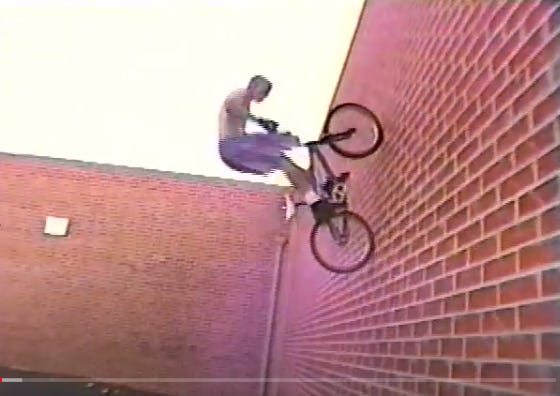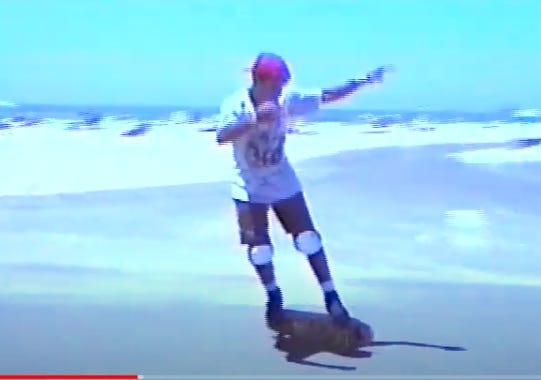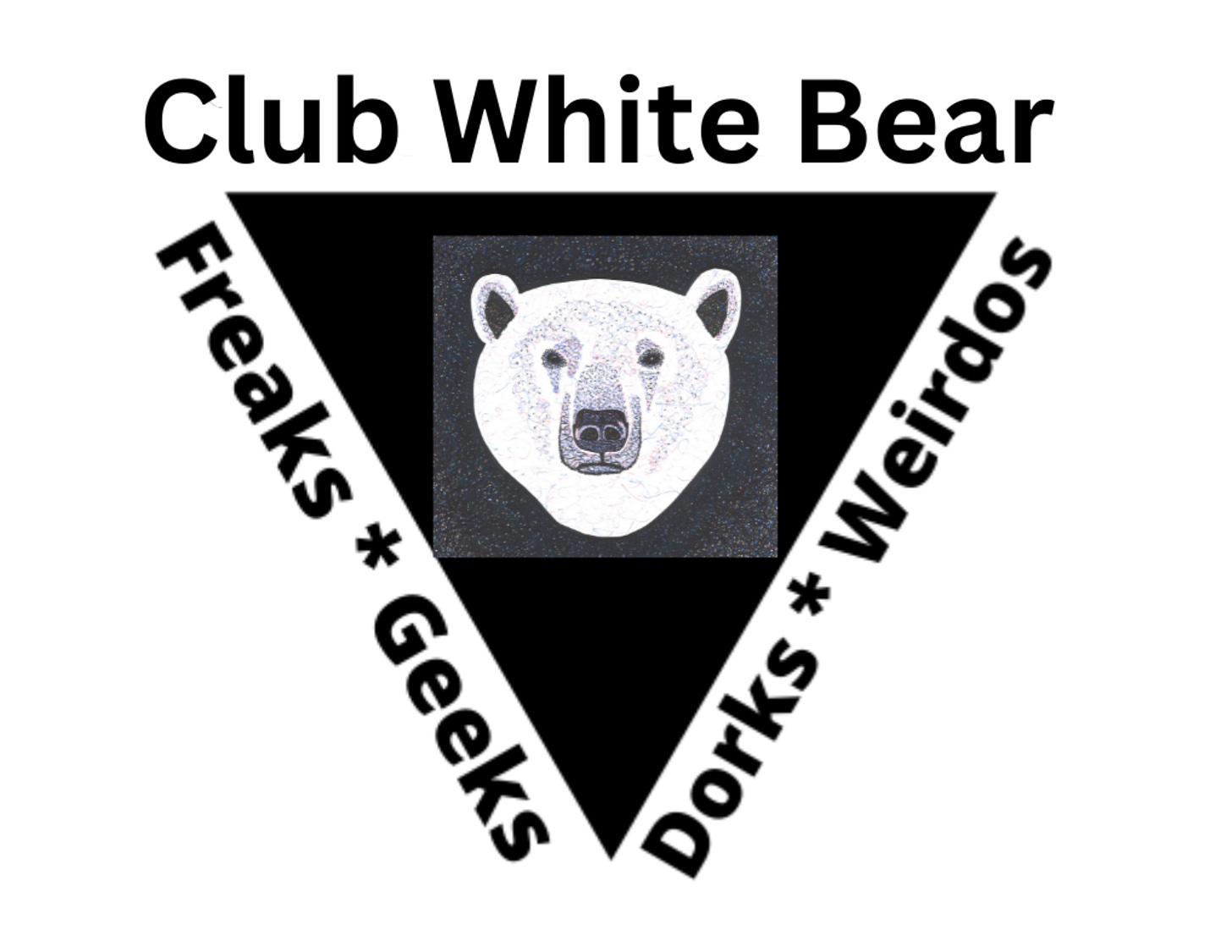Creativity: The Two Magic Questions for Creative Work
When I look back at all the cool projects I've done or worked on, almost all of them started with one of two great questions...
New Jersey born and bred shredder, Keith Treanor, early in his years in Southern California, busting a huge fakie wall ride, in Garden Grove. Video still shot from The Ultimate Weekend, 1990, the first BMX video I fully self-produced. I kept asking myself, “Why doesn’t somebody make a video that shows the way we actually ride?” So I did it.
What does it take to make a cool, creative project? First it takes an idea. Then it takes a bunch of work, to make the project happen, and bring it in to a finished conclusion, whatever that may be. How do you come up with cool ideas? Over the years, I worked on projects of my own, I worked as a sidekick to several entrepreneurs I knew in the BMX and skateboard worlds, and I worked on many much larger projects, like working on the crew of home videos, TV shows, and even Cirque du Soleil. After a while, I learned that the ideas for most of the best projects come from asking yourself one of two simple, basic questions. I call these the Two Magic Questions. They are:
Why doesn’t someone make (or do)_________________________?
Wouldn’t it be cool if we _____________________________________?
Fill in the blanks.
Everyone has ideas, even people who don’t consider themselves creative. They are not all good ideas, but I think everyone has some good really good ideas at some point in their lives. People who do a lot of creative work, just work with those ideas, and bring them to fruition on a more frequent basis.
When I was in high school, I hung out with a cool group of guys who were mostly into outdoor stuff, like fishing, hunting, shooting, and fixing up their VW bugs. We lived in Boise, where there was a lot of “outdoors” in every direction. Like typical high school and college age kids, we’d sit around drinking beer at night, maybe taking a few bong rips, watching MTV, and talking. Like most groups of young people, we had all kinds of ideas that seemed good at the time. One afternoon, my best friend Darrin had an idea. His girlfriend’s birthday was that day. “Hey, let’s go out to that flower farm out by Barber Park tonight, pick a whole bunch of flowers, and put them all over her truck while she’s at work at the pizza place.” It seemed like a cool idea at the time.
That night we drove out past what was the edge of town then, to these huge fields of flowers. We parked on the side of the road near the flower farm, and dashed out into the field, trying not to be seen. We went into the middle of the field with garbage bags, picked hundreds of flowers, and stuffed them in the garbage bags. We got back to his car without anyone confronting us. He drove to the parking lot of the shopping center where his girlfriend worked, and we put flowers all over her Toyota pick up. We took off.
Then we went back to the pizza place about 9:45, got a drink, and hung out inside until she got off work around 10:00 pm. She walked out with us, as we tried to keep straight faces. Much to our surprise, she went berserk. From a distance, it looked like someone had put trash all over he truck. Even when she got up to it, and saw it was flowers, she was still mad. Generally, she was really cool, but the flower idea didn’t go over well. Hey, seeming great ideas can’t all be winners.
That same group of guys had lots of other ideas, most of which never got acted upon, like young people everywhere. “Hey, we should get a keg, and have a party out at the lake 15 miles outside of town.” “Hey, I should start a fishing TV show.” “Hey, why doesn’t somebody make a soap opera called, “‘As the Bong Bubbles?’” For the most part, like most people, we never acted on most of those ideas.
Former Redline and General pro rider, Todd Anderson, with a barspin tailtap, on Martin Aparijo’s quarterpipe, in The Ultimate Weekend, 1990. Still from video.
When I got deeper into BMX freestyle, I spent more time around highly entrepreneurial people. Ideas then were more like, “We should start a trick team.” “I should make a zine,” “We should start a band,” “Why doesn’t someone make stronger handlebars?” or “We should build a backyard mini ramp.” My focus on BMX freestyle moved me into a group of people with a much more D.I.Y. (Do It Yourself) mentality. The DIY ethic really got going with 1970’s punk rock, and then seeped into skateboarding, BMX, snowboarding, and the early action sports world.
That’s when we started asking ourselves questions like, “Why doesn’t somebody make a BMX bike designed for freestyle?” That question led Bob Haro to create the Haro Freestyler bike in 1983. “Why doesn’t somebody make a BMX bike with rear dropouts that don’t bend when we jump?” That question led to one of today’s most popular BMX bike companies. In 1990, after working on Vision’s kind of cheesy BMX video, Freestylin’ Fanatics, I asked myself, “Why doesn’t somebody make a BMX freestyle video showing the real riding we do every day?” Freestylin’ Fanatics wasn’t terrible, in the context of the small number of BMX freestyle videos available at the time. But the footage was all old when it was made, in a young sport that was progressing at a vary rapid pace. It had guys riding flatland in helmets and leathers, and almost no street riding, which was becoming more popular. More than anything else, my name was in the credits, twice, and I had no creative input to the video.
I kept asking myself, as a low level worker at a video company, “Why doesn’t anybody make a video that shows real, everyday riding?” That question led to the eventual thought, “Ah hell, I’ll do it myself.” Over the years, I began to realize that how A LOT of creative projects get started. In this case, I decided to make my own video, at a time where only BMX manufacturers and magazines made videos, mostly. In 1990, I shot and produced my own bike video, and became one of the first three riders to do that. I put out The Ultimate Weekend, showing the guys I rode with often, a whole bunch of top riders. We went to all kinds of places and events to ride our bikes, and session with other top riders of that time period. For me, at the time, putting out a 45 minute video was a huge challenge, but I pulled it off, inspired by all the other entrepreneurs I knew, and had worked with for the previous four years.
Dan Hubbard with a big tailwhip flyout, landing on his feet. This was one of the tricks he did during his trick team shows, overlooking the Pacific ocean and Palos Verdes. Dan was one of the few guys to run a successful, profitable, BMX trick team in the late 1980’s, and beyond. Dan went on to become a stunt man, and now announces Supercross races. Video still from The Ultimate Weekend, 1990.
That’s an example of the first magic question, “Why doesn’t somebody make (or do)_____________? Nobody was making the type of BMX freestyle video I wanted to watch, so I made my own. That got me work making a couple videos for a fledgling bike company in the next couple of years afterwards. I wound up on the cutting edge of a huge movement, rider-made action sports videos. With the rapid price drops in prosumer video equipment, all kinds of people started making BMX, skateboarding, and snowboarding videos in the early 1990’s, and the trend continued through the action sports world. In those days, we just wanted to make cool videos, and possibly break even money-wise, if possible. But quite a few professional video and film production people came out of the action sports world, movie director (and Oscar winner) Spike Jonze, being the most notable.
The second magic question is similar. “Wouldn’t it be cool if we_______________?” Again, fill in the blank. If we went on a road trip to the alien museum in Roswell, New Mexico. If we started an indie art gallery. If we made an app that told us where the best microbreweries were across the country. If we went on that surf trip to Tahiti that we keep talking about?
The answer is different for every person or group of people. Nearly everyone does this on a regular basis, most people ask these kinds of questions. This is one of the best ways that cool new ideas, and some not so cool ideas, like the flowers on my friend’s girlfriend’s truck, are born. Every group of friends has ideas that they talk about on a regular basis, and ideas that pop up sporadically. But most people work fairly traditional jobs, and live reasonably “normal” lives, and don’t act on most of their ideas.
Acting on your good ideas is another matter. Mainstream culture, whatever the flavor, generally doesn’t not encourage people to go off and try out new ideas. Because of this, most people in the Industrial Age, grew up in a culture that where few people go out and create art, make music, start new businesses, or do other highly creative projects. But with the advent of the Information Age, and new technologies like personal computers, smart phones, the internet, social media, worldwide communications platforms, and the ability to do business around the world as an individual or small group, the game has changed.
Today’s young people have lots of models of people who have taken ideas, turned them into a start-up business, and found some level of success. In some cases, these may be local small businesses, like that cool cupcake bakery or indie coffee shop in your town. In other cases some of these start-ups became huge, worldwide busnesses, and the founders became billionaires in 10 or 20 years, creating infrastructure or systems for this emerging Information Age. In the 2020’s, it’s cool to try new ideas out in the arts, business, or social causes. Today’s culture in 2023, particularly with the Millennials and Gen Z, is much more open to creativity and project-oriented work, rather than the long term jobs in factories that their parents or grandparents worked.
The only skateboarder who appeared in The Ultimate Weekend, Pierre Andre’ Senizergues, riding on two wheels. For you skaters out there, this is not a Primo slide. At the time I shot this video, Pierre was three years into his own project, which started with the question, “Why doesn’t someone make really good shoes, designed specifically for skateboarding?” That question led to Etnies shoes, and eventually Sole Technology, which includes Etnies, e’S shoes and other brands.
So those are the Two Magic Quesitons that I’ve seen many people ask throughout my lifetime, and which often lead to really amazing projects of all kinds. Fill in the blanks for yourself, and see what ideas pop into your head.
In future posts, I’ll go into more ideas about taking what seems to be a good idea, and actually putting it into action, and making it happen. I’ve done that, and not done that, many times in my own life. I’ve also worked on many creative projects that other people came up with. There are all kinds of issues and beliefs involved with actually going forward with your ideas. But the point of this post is to give all of you readers the two magic questions, and let you ask yourself those questions, and see what ideas bubble up to the surface.








